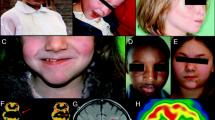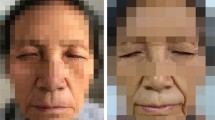Abstract
Introduction
Parry–Romberg syndrome (progressive facial hemiatrophy) is a unilateral, slowly progressive atrophy affecting the skin, subcutaneous tissues, muscles, and bones. The relationship between Parry–Romberg syndrome and connective tissue disorders, especially scleroderma en coup de sabre, is still unclear. The neurological symptoms, including epilepsy, migraine, and brain lesion, on neuroimaging may be similar. Rasmussen encephalitis (RE) is connected with chronic inflammation and damage of one hemisphere. Clinically, it is manifested by epileptic partial seizures and unilateral neurological symptoms.
Case Report
The authors present the case of a 10-year-old girl with features suggestive of RE, with refractory partial motor dextrolateral seizures followed by development of hemiparesis and with progressive intellectual deterioration. At the age of 2 years, some changes on the left part of the face typical of Parry–Romberg syndrome or a linear form of scleroderma were noticed.
Discussion
The authors discussed the difficulties in differential diagnosis in that patient. The presented girl constitute the case from the borderline zone of the aforementioned disorders.



Similar content being viewed by others
References
Andrew R et al (1998) Progressive facial hemiatrophy: abnormality of intracranial vasculature. Neurology 50:1915–1917
Blaszczyk M et al (2003) Progressive facial hemiatrophy: central nervous system involvement and relationship with scleroderma en coup de sabre. J Rheumatol 30:1997–2004
Cohen MM (2001) Asymmetry: molecular, biologic, embryopathic, and clinical perspectives. Am J Med Genet 101:292–314
DeFelipe J et al (2001) Neuropathological findings in a patient with epilepsy and the Parry–Romberg syndrome. Epilepsia 42:1198–1203
Derex L, Isnard H, Revol M (1995) Progressive facial hemiatrophy with multiple benign tumors and hamartomas. Neuropediatrics 26:306–309
Dupont S et al (1997) Progressive facial hemiatrophy and epilepsy. Neurology 48:1013–1018
Gamblicher T et al (2001) Bilateral linear scleroderma en coup de sabre” associated with facial atrophy and neurological complications. BMC Dermatol 1:9–13
Granata T et al (2003) Rasmussen’s encephalitis: early characteristics allow diagnosis. Neurology 11:422–425
Grosso S et al (2003) Linear scleroderma associated with progressive brain atrophy. Brain Dev 25:57–61
Hart YM et al (1998) Double pathology in Rasmussen’s syndrome? A window on the etiology? Neurology 50:731–735
Higashi Y, Kanekura T, Fukumaru K, Kanzaki T (2000) Scleroderma en coup de sabre; central nervous system involvement. J Dermatol 27:486–488
Jablonska S, B3aszczyk M (1998) Scleroderma-like disorders. Semin Cutan Med Surg 17:65–76
Marzano AV et al (2003) Localized scleroderma in adults and children. Clinical and laboratory investigations of 239 cases. Eur J Dermatol 13:171–176
Morse RP (2004) Rasmussen encephalitis. Arch Neurol 61:592–594
Maeda Y et al (2003) Rasmussen syndrome: multifocal spread of inflammation suggested from MRI and PET findings. Epilepsia 44:1118–1121
Obermoser G et al (2003) Scleroderma en coup de sabre with central nervous system and ophthalmologic involvement: treatment of ocular symptoms with interferon gamma. J Am Acad Dermatol 49:346–543
Orozco-Covarrubias L et al (2002) Scleroderma “en coup de sabre” and progressive facial hemiatrophy. Is it possible to differentiate them? J Eur Acad Dermatol Venereol 16:361–366
Pardo CA et al (2004) The pathology of Rasmussen syndrome: stages of cortical involvement and neuropathological studies in 45 hemispherectomies. Epilepsia 45:516–526
Pichiecchio A et al (2002) Parry–Romberg syndrome with migraine and intracranial aneurysm. Neurology 59:606–608
Santagati F, Rijli F (2004) Cranial neural crest and the building of the vertebrate head. Nat Rev Neurosci 4:806–818
Schievink WI et al (1995) Spontaneous carotid-jugular fistula and carotid dissection in a patient with multiple intracranial arachnoid cysts and hemifacial atrophy: a generalized connective tissue disorder? Case report. J Neurosurg 83:546–549
Shah JR et al (2003) Rasmussen encephalitis associated with Parry–Romberg syndrome. Neurology 61:395–397
Stone J, Franks AJ, Guthrie JA, Johnson S (2001) Scleroderma “en coup de sabre”: pathological evidence of intracerebral inflammation. J Neurol Neurosurg Psychiatry 70:382–385
Stone J (2003) Parry–Romberg syndrome. A global survey of 205 patients using the Internet. Neurology 61:674–676
Tebias SM et al (2003) Bilateral Rasmussen encephalitis: postmortem documentation in a five-year-old. Epilepsia 44:127–130
Woolfenden AR et al (1998) Progressive facial hemiatrophy: abnormality of intracranial vasculature. Neurology 50:1915–1917
Yano T et al (2000) Progressive facial hemiatrophy after epileptic seizures. Pediatr Neurol 23:164–166
Fry JA et al (1992) Intracranial findngs in progressive facial atrophy. J Rheumatol 19:956–958
Chung MH et al (1995) Intracerebral involvement in scleroderma en coup de sabre: report of a case with neuropathologic findings. Ann Neurol 37:679–681
Liu P et al (1994) Localized scleroderma: imaging features. Pediatr Radiol 24:207–209
Ternsteege K et al (1994) MR of the brain involvement in progressive facial hemiatrophy. (Romberg Disease): reconsideration of a syndrome. Am J Neuroradiol 15:145–150
Luer W et al (1990) Progressive inflammatory lesions of the brain parenchyma in localized scleroderma of the head. J Neurol 237:379–381
Goldberg-Stern H, deGrauw T, Passo M, Ball WS Jr (1997). Parry Romberg syndrome: Follow-up imaging during suppressive therapy. Neuroradiology 39:873–876
Cory RC et al (1997). Clinical and radiologic findings in progressive facial hemiatrophy (parry-Romberg syndrome). Am J Neuroradiol 18:751–757
Wolf SD, Verity MA (1974). Neurological complications of progressive facial hemiatrophy. J Neurol Neurosurg Psychiatry 37:997–1004
Verity C, Firth H, French-Constant C (2003). Congenital abnormalities of the central nervous system. J Neurol Neurosurg Psychiatry 74(suppl1):3–8
Dubeau F et al (1988) Morphoea or focal scleroderma of the brain: intractable epilepsy and clinicopathologic correlation. Epilepsia 29:712–713
Wartenberg R et al (1945) Progressive facial hemiatrophy. Arch Neurol Psychiatry 54:75–96
Author information
Authors and Affiliations
Corresponding author
Rights and permissions
About this article
Cite this article
Paprocka, J., Jamroz, E., Adamek, D. et al. Difficulties in differentiation of Parry–Romberg syndrome, unilateral facial sclerodermia, and Rasmussen syndrome. Childs Nerv Syst 22, 409–415 (2006). https://doi.org/10.1007/s00381-005-1262-x
Received:
Published:
Issue Date:
DOI: https://doi.org/10.1007/s00381-005-1262-x




